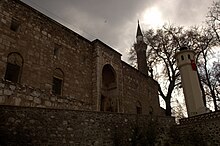Sarukhanids

The Saruchanids (Turkish: Saruchan-Qghullari ( DMG Ṣaruḫān-Oġullarï ) or Saruhanoğulları - "the sons of Saruchan") were a Turkish local dynasty that ruled over a western Anatolian principality ( Beylik ) with the capital Manisa from around 1313 to 1410 . Their rulership, located in old Lydia , was one of the best-known frontier principalities ( Uc ) of the Oghusian tribes after the fall of the Rumseldschuks sultanate .
history
The rulers of the Saruchanids were members of the Oghuz tribe Afshar . The founder and namesake of the dynasty, Saruchan Beg ibn Alpagi, was the grandson of an Oghuz commander in the service of the Seljuks and began his military career as an emir with the Germiyan . At the beginning of the 14th century he conquered Byzantine territory in the Gediz region and around 1313 finally also took the city of Manisa, which became the residence of the Saruchanids. From here Saruchan ruled the fertile coastal area of the ancient region of Lydia with cities like Menemen , Gördes , Demirci , Nif and Turgutlu . In the coastal cities, the Saruchanids maintained a powerful pirate fleet.
The position of the Beyliks as a regional power, which (because of its fleet) was mainly active in the Aegean Sea , was closely related to its ruler Saruchan Beg. He made a pact with the neighboring ruler Umur Bey from the Aydınid dynasty and undertook raids with him against Byzantium and the Genoese . Saruchan Beg died after 1348; his successors Ilyas and Ishaq then came to the fore with construction work. In 1374, Ishaq had the Great Mosque (tr: Ulu Camii ) built by Manisa, the prayer hall of which is crowned by a 14-meter-wide dome. The building served as a model for the Üç-Şerefeli Mosque, which was built 60 years later by the Ottoman Sultan Murad II in Manisa. In 1390 the Beylik was conquered by the Ottomans under Bayezid I and incorporated into the expanding Ottoman Empire . But with the defeat of Sultan Bayezid against Timur near Ankara in 1402 , it regained its independence under Orchan like the other Beyliks. After the Ottomans had rallied again, Beyazid's son Mehmed I subjugated the Beylik again in 1410 and killed its last ruler, Chidr-Shah. Since then it has been Ottoman as a sanjak . In addition, many Ottoman princes such as the later Sultan Mehmed II were installed as governors in Manisa, so that the city continued to expand.
In the first years of the Republic of Turkey - the successor state of the Ottoman Empire - the name Saruhan was a common name for today's Manisa province .
Ruler list
- Saruchan -Beg ibn Alpagi ( Ṣaruḫān -Beg b. Alpagï), reg. approx. 1313-1348
-
- Fachr ad-Din Ilyas ibn Saruchan (Faḫr ad-Dīn Ilyās b. Ṣaruḫān), r. approx. 1348-1357
-
- Muzaffar ad-Din Ishaq Tschelebi ibn Ilyas (Muẓaffar ad-Dīn Isḥāq Čelebi b. Ilyās), r. approx. 1357-1388
- Khidr -Schah ibn Ishaq ( HIDR -Šāh b. Ishaq), reg. ca. 1388-1390 and 1404-1410
- Orchan ibn Ishaq ( Orḫan b.Isḥāq ), r. approx. 1402-1404
Individual evidence
- ^ Godfrey Goodwin: A History of Ottoman Architecture . Thames and Hudson, London 1971, ISBN 0500340404 , pp. 25-7.
literature
- Stanford Shaw : History of the Ottoman Empire and Modern Turkey . 1st edition. Cambridge University Press, 1976, ISBN 978-0-521-29163-7 , pp. 10 .
- Speros Vryonis : The Decline of Medieval Hellenism in Asia Minor and the Process of Islamization from the Eleventh through the Fifteenth Century . In: Publications of the Center for Medieval and Renaissance Studies . 4th edition. University of California Press, Los Angeles 1971, ISBN 0-520-01597-5 , pp. 138-39 .

